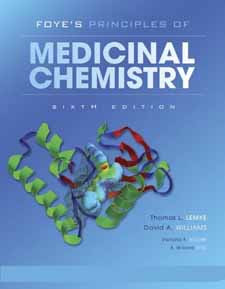
Thomas L. Lemke, David A. Williams, "Foye's Principles of Medicinal Chemistry, 6 Edition"
LW & W | 2007 | ISBN: 0781768799 | 1377 pages | PDF | 57 MB
The Sixth Edition of this well-known text has been fully revised and updated to meet the changing curricula of medicinal chemistry courses. Emphasis is on patient-focused pharmaceutical care and on the pharmacist as a therapeutic consultant, rather than a chemist.
A new disease state management section explains appropriate therapeutic options for asthma, chronic obstructive pulmonary disease, and men's and women's health problems. Also new to this edition: Clinical Significance boxes, Drug Lists at the beginning of appropriate chapters, and an eight-page color insert with detailed illustrations of drug structures.
Case studies from previous editions and answers to this edition's case studies are available online at thePoint.
Download
Link 1
or
Link 2

5 comments:
Drug modeling, and quantum pharmacognosy, have research progress ongoing which relies on data density to challenge the pico/femtoscale horizon of quantum effects and relativistic features. That depends on the atomic topological function applied in modeling for design and analysis tasks. Recent advancements in quantum science have produced the picoyoctometric, 3D, interactive video atomic model imaging function, in terms of chronons and spacons for exact, quantized, relativistic animation. This format returns clear numerical data for a full spectrum of variables. The atom's RQT (relative quantum topological) data point imaging function is built by combination of the relativistic Einstein-Lorenz transform functions for time, mass, and energy with the workon quantized electromagnetic wave equations for frequency and wavelength.
The atom labeled psi (Z) pulsates at the frequency {Nhu=e/h} by cycles of {e=m(c^2)} transformation of nuclear surface mass to forcons with joule values, followed by nuclear force absorption. This radiation process is limited only by spacetime boundaries of {Gravity-Time}, where gravity is the force binding space to psi, forming the GT integral atomic wavefunction. The expression is defined as the series expansion differential of nuclear output rates with quantum symmetry numbers assigned along the progression to give topology to the solutions.
Next, the correlation function for the manifold of internal heat capacity energy particle 3D functions is extracted by rearranging the total internal momentum function to the photon gain rule and integrating it for GT limits. This produces a series of 26 topological waveparticle functions of the five classes; {+Positron, Workon, Thermon, -Electromagneton, Magnemedon}, each the 3D data image of a type of energy intermedon of the 5/2 kT J internal energy cloud, accounting for all of them.
Those 26 energy data values intersect the sizes of the fundamental physical constants: h, h-bar, delta, nuclear magneton, beta magneton, k (series). They quantize atomic dynamics by acting as fulcrum particles. The result is the exact picoyoctometric, 3D, interactive video atomic model data point imaging function, responsive to keyboard input of virtual photon gain events by relativistic, quantized shifts of electron, force, and energy field states and positions.
Images of the h-bar magnetic energy waveparticle of ~175 picoyoctometers are available online at http://www.symmecon.com with the complete RQT atomic modeling manual titled The Crystalon Door, copyright TXu1-266-788. TCD conforms to the unopposed motion of disclosure in U.S. District (NM) Court of 04/02/2001 titled The Solution to the Equation of Schrodinger.
http://www.megaupload.com/?d=AAUF2CPD
http://depositfiles.com/en/files/r33xi0mug
http://hotfile.com/dl/27422614/3b60561/Foye_s_principles_of_medicinal_chemistry.pdf.html
http://www.zshare.net/download/72225595d4b67551/
http://www.badongo.com/file/20326905
http://uploading.com/files/fmm691a3/Foye%2Bs%2Bprinciples%2Bof%2Bmedicinal%2Bchemistry.pdf/
Thankssss
thank you for this post
thanks for free ebooks